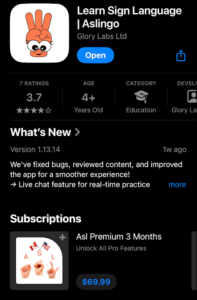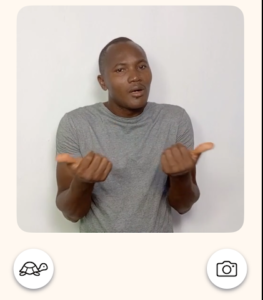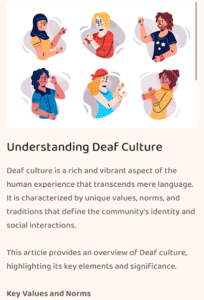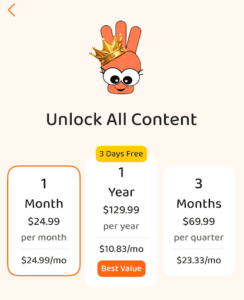As the weeks go on, finding new apps for my ASL learning journey becomes increasingly harder. I could download an app with little to no user-access and blog about how it’s a terrible app and not to download it or buy it when it’s demanded. However, the reason I’m learning ASL is for such an amazing purpose; making communication and equity a priority for any student who comes into my classroom. So, I scrolled on the app store for a good few minutes, passing apps that were two stars and cost money to download. Eventually, I came across some friendly-looking apps with pretty good reviews. With the little ‘ding’ of confirmation, I downloaded ASLingo.
ASLingo

ASLingo is quite similar to Lingvano, one of the apps I reviewed in a previous post. The app starts you off with lessons on Greetings. Once you complete the four mini-lessons, there is a small quiz/recap of the lesson, then you can move onto the next one. I loved this format because the greetings are some of the most-used signs in ASL. This is also a great learning path for me, as I love the structure of lessons and quizzes over trying to choose and figure all of it out on my own. I also appreciated these lessons because I could see a great amount of variation.

For example: “how.” In a previous post, I gave two variations of how, including it in a video. In ASLingo, they gave another variation, one that was similar, and in my opinion, easier. All you have to do is point your thumbs outwards and bring your hands from together to outward.
 My favourite aspect of the app is the Journal section. In the journal, they have topics for advocacy and culture. On the side I’ve provided an example on the Understanding Deaf Culture journal. When you click on it, it gives you a few quick paragraphs of information on the topic, allowing the user to research and develop their ASL understanding more in-depth.
My favourite aspect of the app is the Journal section. In the journal, they have topics for advocacy and culture. On the side I’ve provided an example on the Understanding Deaf Culture journal. When you click on it, it gives you a few quick paragraphs of information on the topic, allowing the user to research and develop their ASL understanding more in-depth.

I compared this app to Lingvano because it was like a copy-paste: the colour scheme, the formatting, and access to dictionary, lesson recaps, etc. The apps are extremely similar in these regards, which made ASLingo a favourite fairly quickly. However, there is a downside. You only get a few days worth of a free trial. After that, you have to pay for most of the features, such as flashcards/recaps, lessons, etc., essentially only leaving the dictionary. As a beginner learning ASL, this app is a great format and source for ASL culture, however, due to the need of payment after only a few days, I would say Lingvano is a great alternative because of its accessibility without the need of payment, and similarity to ASLingo.
What I Learned This Week
This week I decided to learn some introductory sentences! I introduced myself “Hi, my name is Carys,” “I have two cats named Theo and Alice,” and “I’m becoming an Auntie in June.” Below is my video showing how to do the signs!
Thank you for joining me this week with my learning project journey!
This is a fantastic and thoughtful review! I appreciate how you not only discuss ASLingo’s features but also compare it to Lingvano, giving readers a well-rounded perspective. The Journal section sounds like a great way to deepen cultural understanding, which is so important in language learning. It’s unfortunate that the free trial is so short, but your suggestion of Lingvano as an alternative is really helpful. Your commitment to making communication equitable for your future students is inspiring—keep up the great work on your ASL journey!
Yes all I could think of was Lingvano as I was using the app! I keep thinking about my future students and how I would want them to have access to learning ASL in the most accommodating way! The need for payment is disappointing but Lingvano is a great alternative!
Hi Carys! I can definitely relate to you with the struggle of finding new platforms to learn your skill. Rebounding is not super popular online, and I’m also finding it hard to find new places to learn from. Looks like you’re navigating this challenge well though!
Thanks! Yes I’ve been keeping up with your rebounding as well and it looks tough to find reliable sources. As long as we review and look for alternatives, regardless of if they’re useful, is all we can do to tell others what the best sources are!
I really appreciated how you created a video and compared/contrasted the new app you were trying to an app you had previously tried! Also, you are doing so well at sign language, I can see your confidence growing in your signing ability as the weeks go along! I think is a neat feature that ASLingo has a journal section with information/articles to help learners better understand deaf culture. It is one thing to know ASL, but learning about the culture behind it is important too, as you have discovered!
Thank you so much! I thought the cultural background option in the app was so neat! Thankfully I’m still able to access it post trial period!
This is such a thoughtful reflection on your ASL learning journey! It’s great that you’re not just looking for any app, but one that truly supports meaningful learning and accessibility. ASLingo sounds like a solid option, especially with its structured lessons and cultural insights, but the paywall is definitely a downside. I love that you’re incorporating personal sentences into your learning, might just have to try it for myself!!
Thank you! Yes, I’ve been keeping up with your journey as well! I keep thinking about which apps I would use for my future students in an ASL unit!
Hi, I am very interested in having you test out my ASL app. I am only in the beginning stages as a business owner. I was an ASL professor for many years and adopted a Deaf son, so I am trying to get free ASL resources out to support learning. If you are willing to meet with me on Zoom, I would love to show you where we are headed in the future.